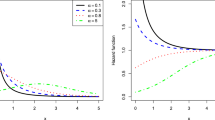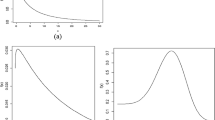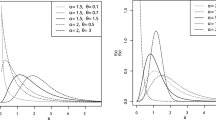Abstract
In the current study, we set out to extend the three-parameter Modified Weibull (MW) distribution in an attempt to propose a four-parameter distribution named the Modified Weibull Poisson (MWP) distribution including such noticeable submodels as Exponential Poisson, Weibull Poisson, and Rayleigh Poisson known as the distributions subsumed under the umbrella term MWP. Depending on its parameter values, this overarching distribution was demonstrated by this work to exhibit some hazard rates like decreasing, increasing, bathtub, and upside-down bathtub ones. In addition to the hazard rates of the MWP, the mathematical properties as well as the properties of maximum likelihood estimations were brought to the forefront, and the very capability of the quantile measures to be explicitly expressed in terms of the Lambert W function was vigorously discussed. To shed light on the functioning of the maximum likelihood estimators and their asymptomatic results for the finite sample sizes, some numerical experiments were carried out leading to two data sets intended chiefly to illustrate or explicate the higher levels of importance and flexibility of the MWP in comparison with its standard counterparts, namely the Weibull, Gamma, and MW distributions.



Similar content being viewed by others
References
Aarset MV (1987) How to identify bathtub hazard rate. IEEE Trans Reliab 36(1):106–108
Barlow RE, Campo RA (1975) Total time on test processes and application to failure data analysis, research report no. ORC 75-8, University of California
Carrasco JMF, Ortega EMM, Corderio GM (2008) A generalized modified Weibull distribution for lifetime modeling. Comput Stat Data Anal 53:450–462
Chen G, Balakrishnan N (1995) A general purpose approximate goodness-of-fit test. J Qual Technol 27(2):154–161
Corless RM, Gonnet GH, Hare DEG, Jeffrey DJ, Knuth DE (1996) On the Lambert W function. Adv Comput Math 5:329–359
Gradshteyn IS, Ryzhik IM (2000) Table of integrals, series, and products, 6th edn. Academic Press, San Diego
Kus C (2007) A new lifetime distribution. Comput Stat Data Anal 51:4497–4509
Lai CD, Xie M, Murthy DNP (2003) A modified Weibull distribution. Trans Reliab 52:33–37
Lawless JF (2003) Statistical models and methods for lifetime data. Wiley, New York
Silva GO, Ortega EMM, Cordeiro GM (2010) The beta modified Weibull distribution. Lifetime Data Anal 16:409–430
Acknowledgments
The authors would like to thank the two anonymous referees and the Associate Editor, for their helpful comments and suggestions specifically on the numerical experiments which helped improve the content of the first, second and third drafts of the manuscript.
Author information
Authors and Affiliations
Corresponding author
Appendix
Appendix
The Fisher observed information matrix for the parameter vector \(\varvec{\theta } \) whose elements are given by:
Using the \(X^{\gamma }e^{\beta X}\sim EP(\alpha ,\lambda )\), the Fisher information matrix can be obtained as:
where \(F_{v,w} \left( {\left[ {a_1 ,\ldots ,a_v } \right] , \left[ {b_1 ,\ldots ,b_w } \right] ,\gamma } \right) \) is the generalized hypergeometric function with the following definition provided by Gradshteyn and Ryzhik (2000).
and \( I\left( {i,j,k,l} \right) =E\left[ {X^{i}\left( {\log X} \right) ^{j} e^{k\beta X-l\alpha X^{\gamma }e^{\beta X}}} \right] \), \(J\left( {i,j} \right) =E\left[ {X^{i}\left( {\gamma +\beta X} \right) ^{-j}} \right] \) are expectations which can be computed numerically.
Rights and permissions
About this article
Cite this article
Delgarm, L., Zadkarami, M.R. A new generalization of lifetime distributions. Comput Stat 30, 1185–1198 (2015). https://doi.org/10.1007/s00180-015-0563-0
Received:
Accepted:
Published:
Issue Date:
DOI: https://doi.org/10.1007/s00180-015-0563-0




